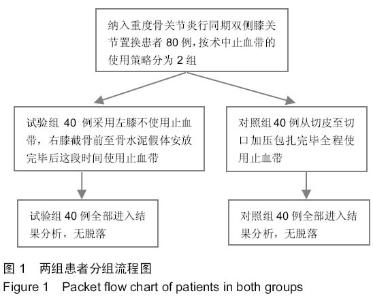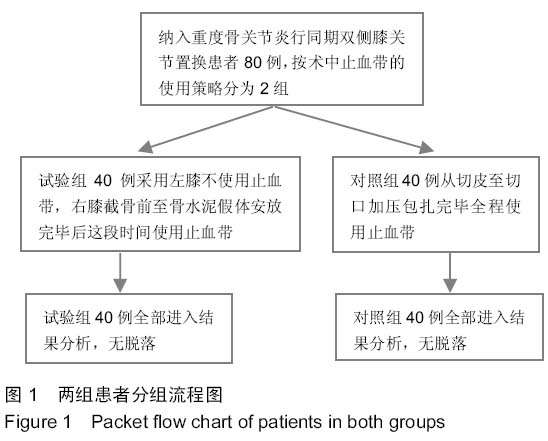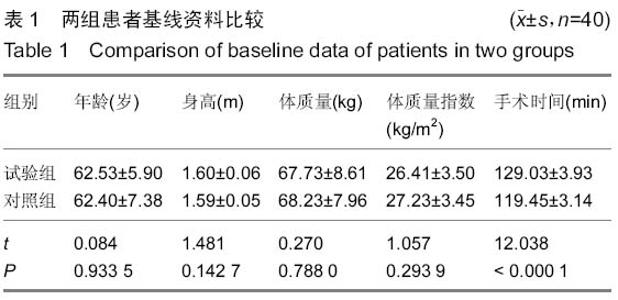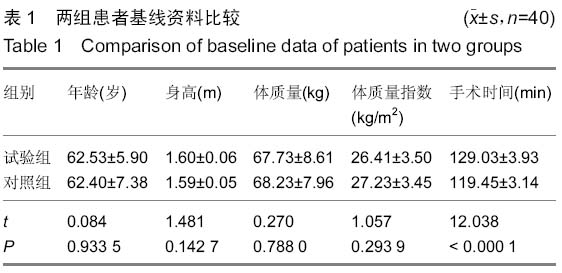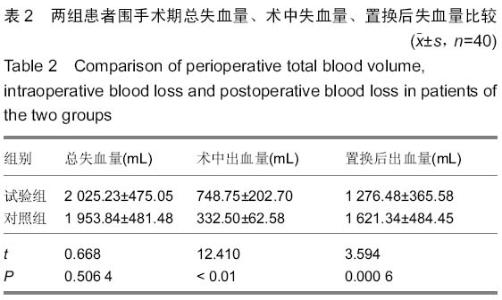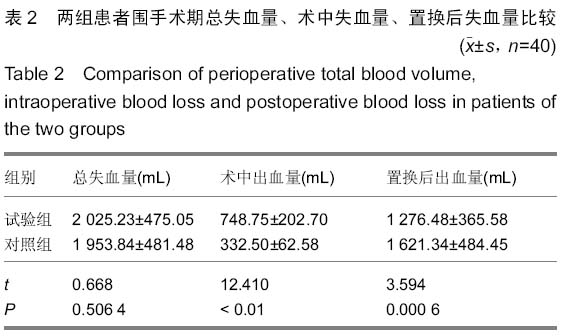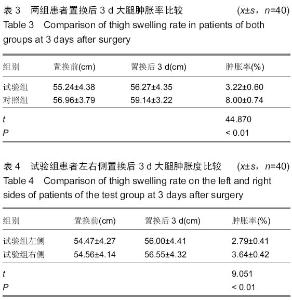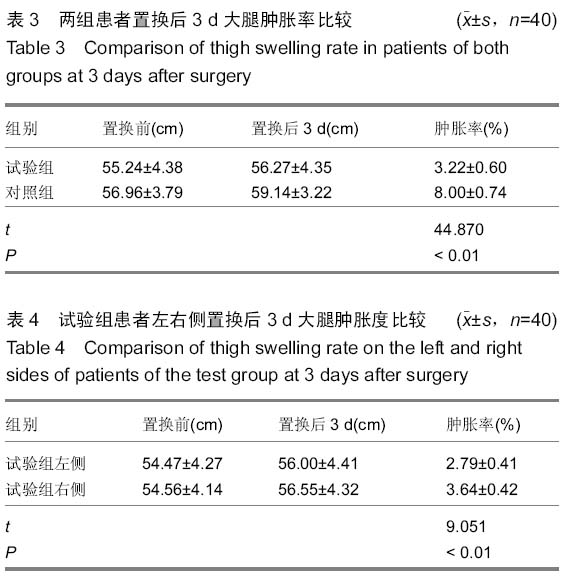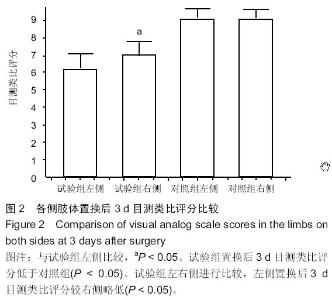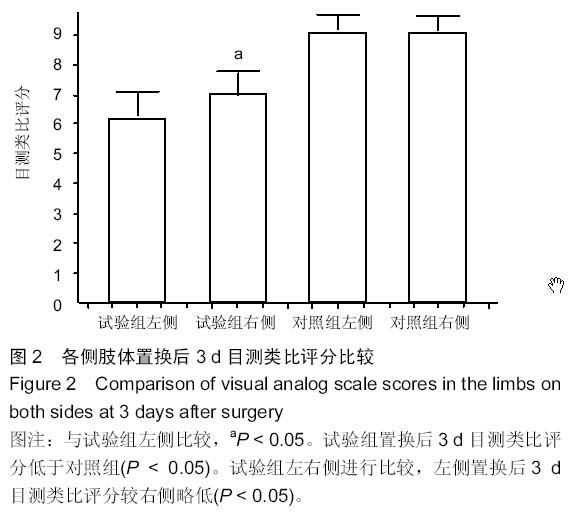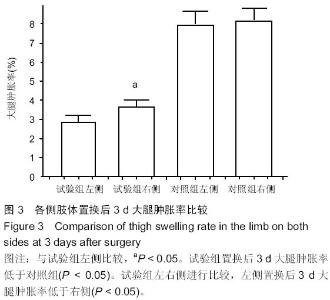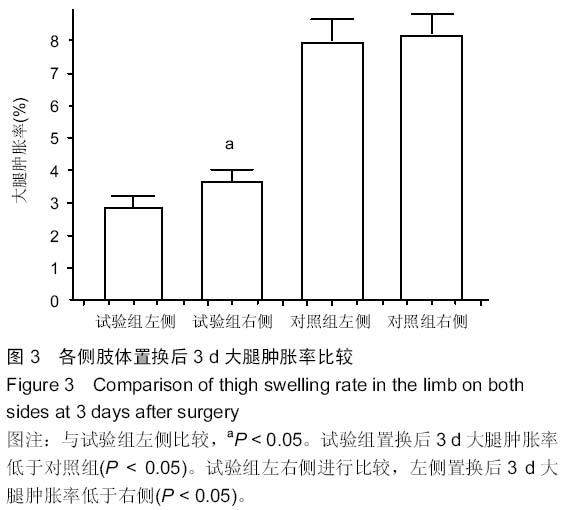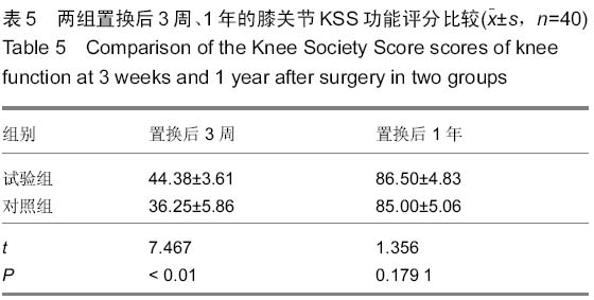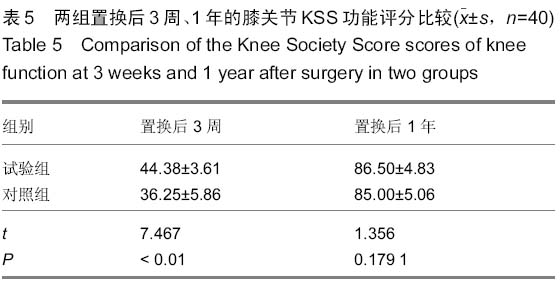Chinese Journal of Tissue Engineering Research ›› 2015, Vol. 19 ›› Issue (39): 6262-6267.doi: 10.3969/j.issn.2095-4344.2015.39.006
Previous Articles Next Articles
Strategy of using a tourniquet in simultaneous bilateral total knee arthroplasty
Gong Ke, An Xiao, Zhang Qi, Dong Ji-yuan
- Department of Orthopedics, Chinese PLA Medical School, Beijing 100853, China
-
Online:2015-09-24Published:2015-09-24 -
About author:Gong Ke, Studying for master’s degree, Physician, Department of Orthopedics, Chinese PLA Medical School, Beijing 100853, China
CLC Number:
Cite this article
Gong Ke, An Xiao, Zhang Qi, Dong Ji-yuan. Strategy of using a tourniquet in simultaneous bilateral total knee arthroplasty[J]. Chinese Journal of Tissue Engineering Research, 2015, 19(39): 6262-6267.
share this article
| [1] 吕厚山.人工关节外科学[M].北京:科学出版社,1999:278-345. [2] Smith TO,Hing CB. Is a tourniquet beneficial in total knee replacement surgery? A meta-analysis and systematic review. Knee. 2010;17(2):141-147. [3] Tai TW, Lin CJ, Jou IM, et al.Tourniquet use in total knee arthroplasty: a meta-analysis. Knee Surg Sports Traumatol Arthrosc. 2011;19 (7):1121-1130. [4] 马卫华,张树栋,王诗军,等.止血带的使用方式对膝关节置换术失血量和手术时间的影响[J].中华关节外科(电子版),2011,5(6): 33-36. [5] 黎笔熙,郭文军,崔桂林,等.不同止血带压力对血流动力学和代谢及再灌注损伤的影响[J].华南国防医学杂志,2008,22(4):36-39. [6] 宋宏阁.同期双侧膝关节置换术中止血带不同使用方法的效果分析[D].新乡医学院,2012. [7] 吴在德,吴肇汉.外科学[M].7版.北京:人民卫生出版社,2008. [8] 卫生部.临床输血技术规范.卫医发[2007]184号文件. [9] Gross JB. Estimating allowable blood loss:corrected for dilution. Anesthesiology. 1983;58(3):277-280. [10] Nadler SB, Hidalgo JU, Bloch T. Prediction of blood volume in normal human adults.Surgery.1962;51(2):224-232. [11] 杨晨,游建军,王利.全膝关节表面置换术中不同时期使用电动止血带的临床效果比较[J].中国现代医学杂志,2014,24(8):71-77. [12] 陈跃平,罗东方,陈亮,等.微孔多聚糖止血球在全膝关节置换术中的应用[J].中国骨与关节损伤杂志,2012,27(10):931-932. [13] Sehat KR,Evans R,Newman JH.How much blood is really lost in total knee arthroplasty? Correct blood loss management should take hidden loss into account. Knee. 2000;7(3): 151-155. [14] 高玉镭,李佩佳,田敏,等.人工全膝关节置换术隐性失血的发生机制及影响因素分析[J].中国矫形外科杂志,2012,20(3): 209-212. [15] Thorey F,Stukenborg-Colsman C,Windhagen H,et al. The effect of tourniquet release timing on perioperative blood loss in simultaneous bilateral cemented total knee arthroplasty: a prospective randomized study. Technol Health Cate. 2008; 16(2):85-92. [16] Kvederas G, Porvaneckas N, Andrijauskas A, et al. A randomized double-blind clinical trial of tourniquet application strategies for total knee arthroplasty. Knee Surg Sports Traumatol Arthrosc.2013;21(12):2790-2799. [17] Yi SX, Tan JX, Chen C, et al. The use of pneumatic tourniquet in total knee arthroplasty:a meta-analysis. Arch Orthop Trauma Surg.2014;134(10):1469-1476. [18] Alcelik I, Pollock RD, Sukeik M, et al. A comparison of outcomes with and without a tourniquet in total knee arthroplasty:a systematic review and meta-analysis of randomized controlled trials. J Arthroplasty. 2012;27(3): 331-340. [19] Tai TW, Chang CW, Lai KA, et al. Effects of tourniquet use on blood loss and soft-tissue damage in total knee arthroplasty: a randomized controlled trial. J Bone Joint Surg Am. 2012; 94(24):2209-2215. [20] 张炜,陈思峰,李宁,等.止血带对初次全膝关节表面置换作用的Meta分析[J].中国关节外科杂志,2014,8(2):62-66. [21] Chen YJ,Wang YP,Chien CT,et al.Small-dose propofol sedation attenuates the formation of reactive oxygen species in tourniquet induced ischemia-reperfusion injury under spinal anesthesia. Anesth Analg. 2002;96(6):1617-1620. [22] Sullivan PJ,Sweency KJ,Hirpara KM,et al.Cyclical ischaemic preconditioning modulates adaptive immune response in human limb ischemia-reperfusion injury. Br J Surg. 2009; 96(4):381-390. [23] Erskine JG,Fraser C,Simpson R,et al.Blood loss with knee joint replacement. J R Coll Surg Edinb. 1981;26(5):295-297. [24] Worland RL,Arredondo J,Angles F,et al.Thigh pain following tourniquet application in simultan eous bilateral total knee replacement arthroplasty. J Arthmplasty. 1997;12(8):848-852. [25] Gao FQ,Li ZJ,Zhang K,et al.Risk factors for lower limb swelling after prinlarytotal knee arthroplasty. Chin Med J. 2011;124(23):3896-3899. [26] Katsumata S, Nagashima M, Kato K, et al. Changes in coagulation fibrinolysis marker and neutrophil elastase following the use of tourniquet during total knee arthroplasty and the influence of neutrophil elastase on thromboembolism. Acta Anaesthesiol Scand. 2005;49(4):510-516. [27] Clarke MT,Longstaf L,Edwards D,et al.Tourniquet induced wound hypoxia after total knee replacement. J Bone Joint Surg Br. 2001;83(1):40-44. [28] Olivecrona C, Lapidus LJ, Benson L, et al. Tourniquet time affects postoperative complications after knee arthroplasty. Int Orthop. 2013;37:827-832. [29] Chen S, Li JP, Peng H,et al. The influence of a half-course tourniquet strategy on peri-operative blood loss and early functional recovery in primary total knee arthroplasty. Int Orthop. 2014;38(2):355-359. [30] Ejaz A, Laursen AC, Kappel A, et al. Faster recovery without the use of a tourniquet in total knee arthroplasty. Acta Orthopaedica. 2014;85(4):422-426. [31] Taylor BC, Dimitris C, Mowbray JG, et al. Perioperative safety of two-team simultaneous bilateral total knee arthroplasty in the obese patient. J Orthop Surg Res. 2010;5:38. [32] Bong MR,Patel V,Chang E,et al.Risks associated with blood transfusion after total knee arthroplasty.J Arthroplasty. 2004; 19(3):281-287. [33] Romagnoli S, Zacchetti S, Perazzo P,et al. Onsets of complications and revisions are not increased after simultaneous bilateral unicompartmental kneearthroplasty in comparison with unilateral procedures. Int Orthop. 2015; 39(5):871-877. [34] Sarkanovi? ML, Gvozdenovi? L, Savi? D, et al. Autologous blood transfusion in total knee replacement surgery. Vojnosanit Pregl. 2013;70(3):274-278. |
| [1] | Huang Dengcheng, Wang Zhike, Cao Xuewei. Comparison of the short-term efficacy of extracorporeal shock wave therapy for middle-aged and elderly knee osteoarthritis: a meta-analysis [J]. Chinese Journal of Tissue Engineering Research, 2021, 25(9): 1471-1476. |
| [2] | Zhong Hehe, Sun Pengpeng, Sang Peng, Wu Shuhong, Liu Yi. Evaluation of knee stability after simulated reconstruction of the core ligament of the posterolateral complex [J]. Chinese Journal of Tissue Engineering Research, 2021, 25(6): 821-825. |
| [3] | Liu Shaohua, Zhou Guanming, Chen Xicong, Xiao Keming, Cai Jian, Liu Xiaofang. Influence of anterior cruciate ligament defect on the mid-term outcome of fixed-bearing unicompartmental knee arthroplasty [J]. Chinese Journal of Tissue Engineering Research, 2021, 25(6): 860-865. |
| [4] | Huang Dengcheng, Wang Zhike, Cao Xuewei. Intravenous, topical tranexamic acid alone or their combination in total knee arthroplasty: a meta-analysis of randomized controlled trials [J]. Chinese Journal of Tissue Engineering Research, 2021, 25(6): 948-956. |
| [5] | He Xiangzhong, Chen Haiyun, Liu Jun, Lü Yang, Pan Jianke, Yang Wenbin, He Jingwen, Huang Junhan. Platelet-rich plasma combined with microfracture versus microfracture in the treatment of knee cartilage lesions: a meta-analysis [J]. Chinese Journal of Tissue Engineering Research, 2021, 25(6): 964-969. |
| [6] | Liu Xin, Yan Feihua, Hong Kunhao. Delaying cartilage degeneration by regulating the expression of aquaporins in rats with knee osteoarthritis [J]. Chinese Journal of Tissue Engineering Research, 2021, 25(5): 668-673. |
| [7] | Xie Chongxin, Zhang Lei. Comparison of knee degeneration after anterior cruciate ligament reconstruction with or without remnant preservation [J]. Chinese Journal of Tissue Engineering Research, 2021, 25(5): 735-740. |
| [8] | Wang Weigang, Yang Zhidong, Feng Zongquan, Wang Ding. A mid-term clinical follow-up of unicompartmental knee arthroplasty with fixed bearing [J]. Chinese Journal of Tissue Engineering Research, 2021, 25(3): 368-373. |
| [9] | Wang Xiaofei, Teng Xueren, Cong Linyan, Zhou Xu, Ma Zhenhua. Herbert screw internal fixation for treating adult osteochondritis dissecans of the knees [J]. Chinese Journal of Tissue Engineering Research, 2021, 25(3): 397-402. |
| [10] | Cheng Chongjie, Yan Yan, Zhang Qidong, Guo Wanshou. Diagnostic value and accuracy of D-dimer in periprosthetic joint infection: a systematic review and meta-analysis [J]. Chinese Journal of Tissue Engineering Research, 2021, 25(24): 3921-3928. |
| [11] | Wang Dasai, Zhang Yang, Cheng Yin, Wang Qiang. Efficacy and safety of staged versus simultaneous unicompartmental knee arthroplasty: a meta-analysis#br# [J]. Chinese Journal of Tissue Engineering Research, 2021, 25(24): 3929-3936. |
| [12] | Luo Anyu, Liu Hanlin, Xie Xiaofei, Huang Chen. Effect of antioxidant mixture on structural degeneration of an osteoarthritis rat model [J]. Chinese Journal of Tissue Engineering Research, 2021, 25(23): 3625-3629. |
| [13] | Yu Yinghao, Zhao Jijun, Liu Dongcheng, Chen Yuhao, Feng Dehong. Clinical significance of preoperative planning assisted unicompartmental knee arthroplasty with digital imaging system for fixed-bearing prosthesis [J]. Chinese Journal of Tissue Engineering Research, 2021, 25(21): 3324-3331. |
| [14] | Deng Zhibo, Li Zhi, Wu Yahong, Mu Yuan, Mu Yuexi, Yin Liangjun. Local infiltration anesthesia versus femoral nerve block for pain control and safety after total knee arthroplasty: a meta-analysis [J]. Chinese Journal of Tissue Engineering Research, 2021, 25(21): 3401-3408. |
| [15] | Xu Hui, Kang Bingxin, Zhong Sheng, Gao Chenxin, Zhao Chi, Qiu Guowei, Sun Songtao, Xie Jun, Xiao Lianbo, Shi Qi. Pressing local acupoints plus adjustion of the knee joint in a sitting position for treating knee osteoarthritis: a randomized controlled trial [J]. Chinese Journal of Tissue Engineering Research, 2021, 25(2): 216-221. |
| Viewed | ||||||
|
Full text |
|
|||||
|
Abstract |
|
|||||
